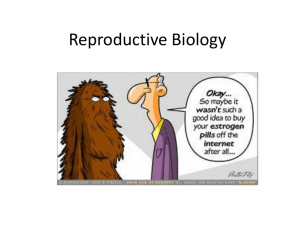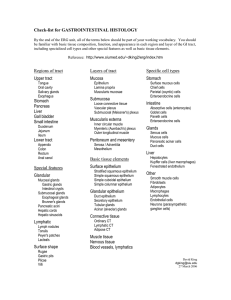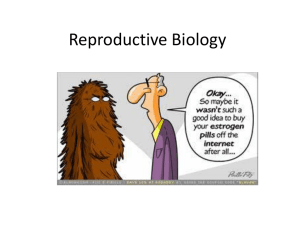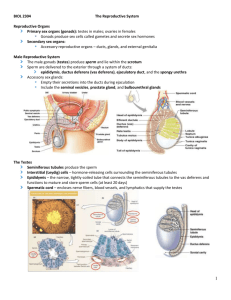I. Anatomy of the Reproductive System A. Gross Anatomy of the
advertisement
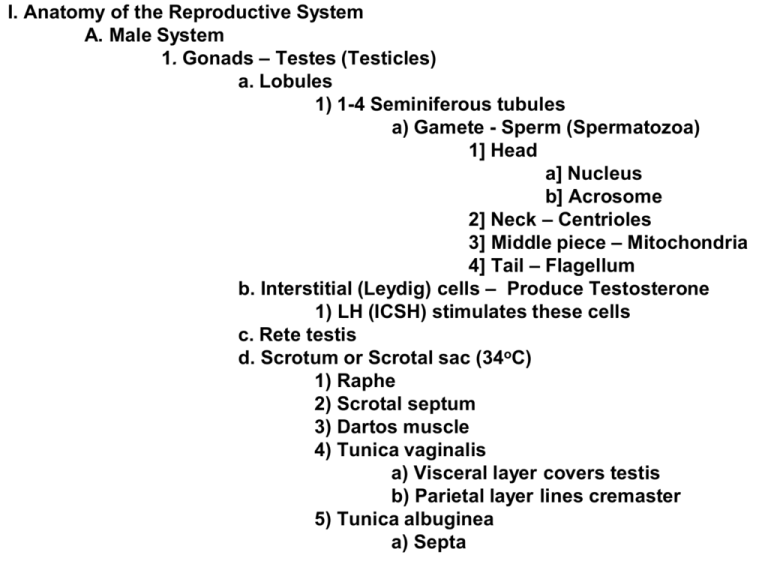
I. Anatomy of the Reproductive System A. Male System 1. Gonads – Testes (Testicles) a. Lobules 1) 1-4 Seminiferous tubules a) Gamete - Sperm (Spermatozoa) 1] Head a] Nucleus b] Acrosome 2] Neck – Centrioles 3] Middle piece – Mitochondria 4] Tail – Flagellum b. Interstitial (Leydig) cells – Produce Testosterone 1) LH (ICSH) stimulates these cells c. Rete testis d. Scrotum or Scrotal sac (34oC) 1) Raphe 2) Scrotal septum 3) Dartos muscle 4) Tunica vaginalis a) Visceral layer covers testis b) Parietal layer lines cremaster 5) Tunica albuginea a) Septa 2. Duct System a. Epididymis 1) Pseudostratified columnar epithelium a) Stereocilia 1] Absorb fluid 2) Smooth muscle a) Peristalsis b. Ductus (Vas) deferens 1) Pseudostratified columnar epithelium 2) Muscularis – 3 layers 3) Inguinal canal a) Clinical Application – Inguinal Hernia 4) Ampulla 5) Ejaculatory duct 6) Spermatic cord a) Testicular artery & vein b) Lymphatic vessel c) Nerve d) Cremaster muscle 7) Clinical Application – Vasectomy 3. Accessory glands a. Semen (Sperm + Seminal fluid) 1) Average 50 – 150 million sperm per milliliter 2) Average 2 – 5 milliliters ejaculate 3) Average lifespan 48 hours in Female system b. Seminal vesicles 1) Alkaline viscous fluid 2) 60% of volume 3) Fructose 4) Prostaglandins 5) Fibrinogen causes clotting 6) Ejaculatory duct a) Ejaculation 7) Histology a) Highly folded glandular tissue b) Smooth Muscle wall c. Prostate gland 1) Slightly acidic milky white fluid which activates sperm 2) 20% - 30% of volume 3) Prostatic urethra 4) Clotting enzymes that coagulate the semen 5) Histology a) Tubuloacinar glands b) Smooth muscle in wall and between glandular units d. Bulbo-urethral (Cowper’s) glands 1) Thick alkaline mucus 2) Rinses urine from urethra 3) Lubricates end of penis 4) 5% of volume – Pre-ejaculation 5) Membranous urethra 6) Histology a) Mucous glands b) Smooth muscle 4. Penis a. Copulatory organ b. Penile (Spongy) urethra 1) External urethral orifice c. Glans 1) Prepuce (Foreskin) a) Clinical Application – Circumcision d. Corona e. Neck f. Body consists of Erectile tissue 1) Corpora cavernosa a) Paired Dorsolateral erectile tissue 2) Corpus spongiosum a) Single Midventral erectile tissue b) Surrounds urethra 3) Erection g. Root 5. Spermatogenesis a. Background 1) Meiosis within Gonads a) Gametes (Sperm and Oocyte) 1] Haploid 2) Fertilization of Sperm and Ovum b) Zygote 1] Diploid Somatic Cells a] Homologous chromosomes b] Mitosis b. Within seminiferous tubules 1) Diploid Spermatogonia – Mitosis 2) Diploid Primary Spermatocytes – Meiosis I a) Synapsis 1] Tetrads 2] Chiasmata (Crossover) b) Reduction Division - Dyads 3) Haploid Secondary Spermatocytes – Meiosis II a) Equational Division 4) Haploid Spermatids – Spermiogenesis a) Physical Maturation 5) Haploid Sperm (Spermatozoa) c. Nurse (Sustenacular or Sertoli) Cells surround developing spermatocytes and spermatids which are incompletely separated 1) Maintenance of the Blood-Testis Barrier a) Basal compartment 1] Spermatogonia b) Luminal compartment 1] Produce luminal fluid 2) Support of Mitosis and Meiosis a) Regulate effects of Follicle-stimulating hormone (FSH) & Testosterone 3) Support of Spermiogenesis a) Provide nutrients to spermatids b) Chemical stimuli promote development c) Phagocytize excess cytoplasm 4) Secretion of Inhibin a) Regulates FSH & Gonadotropin releasing hormone (GnRH) secretion 5) Secretion of Androgen-Binding Protein (ABP) 6) Secretion of Mullerian-Inhibiting Factor (MIF) d. Spermiation – Sperm releases from Nurse Cell B. Female System – Study of Gynecology 1. Ovaries a. Function 1) Produce & Discharge Secondary Oocytes a) Ovulation 2) Secrete Estrogen & Progesterone b. Gross Anatomy 1) Tunica albuginea 2) Stroma a) Medulla b) Cortex 1] Contains Egg nests c. Supporting Ligaments 1) Mesovarium of Broad ligament 2) Ovarian ligament 3) Suspensory ligament of ovary– Lateral d. Histology – covered with Oogenesis 2. Uterine (Fallopian) tubes (Oviducts) a. Function 1) Site of Fertilization 2) Transport to Uterus b. Gross Anatomy 1) Fimbriae 2) Ampulla 3) Isthmus c. Supporting Ligaments 1) Mesosalpinx of Broad ligament d. Histology 1) Ciliated simple columnar epithelium 2) Lamina propria 3) Smooth muscle e. Clinical Application 1) Tubal Ligation 2) Pelvic Inflammatory Disease (PID) 3. Uterus (Womb) a. Function 1) Site of Implantation of Fertilized Ovum 2) Development of Fetus 3) Site of Menstruation b. Gross Anatomical Regions 1) Fundus 2) Body a) Uterine cavity 3) Cervix a) Uterine cavity 4) Uterine horns (cornua)* CAT NOT HUMAN c. Supporting Ligaments 1) Broad ligament a) Lateral fold of Peritoneum b) Majority is Mesometrium 2) Uterosacral ligaments 3) Round ligaments a) From Uterus through Inguinal canal to Labia majora 4) Cardinal ligaments d. Histology 1) Perimetrium a) Serosa – Visceral Peritoneum b) Broad Ligament continues from it 2) Myometrium – 3 layers of smooth muscle 3) Endometrium a) Basilar zone (Statum basalis) b) Functional zone (Stratum functionalis) 1] Menstruation (Menses) 2] Simple columnar epithelium 3] Uterine glands 4] Highly vascularized e. Uterine (Menstrual) Cycle – Menarche to Menopause 1) Menses (Menstrual phase) – 5 days a) Functional endometrium shed 1] 35 – 50 ml blood 2] Declining levels of estrogen & progesterone constrict arteries 2) Proliferative phase – Variable 6 – 14 days a) Endometrium repair & thickening 3) Secretory phase – 14 days a) Growth & Coiling of Glands 1] Glycogen b) Vascularization c) Thickening d) Increased amount of tissue fluid 4. Vagina a. Function 1) Copulatory Receptacle 2) Birth Canal 3) Passageway of Menstrual flow b. Histology 1) Nonkeratinized stratified squamous epithelium 2) Rugae 3) Muscularis a) Outer circular b) Inner longitudinal c. Gross Anatomical Structures 1) Fornix (Fornices) 2) Vaginal Orifice a) Hymen 1] Vascularized mucous membrane b) Greater Vestibular (Bartholin’s) glands 5. Vulva or External Genitalia (Pudendum or Perineum) a. Mons pubis b. Labia majora (Labium majus) c. Labia minora (Labium minus) d. Clitoris 1) Glans 2) Prepuce 3) Erectile tissue e. Vestibule – contains: 1) Vaginal orifice 2) Hymen 3) External Urethral orifice f. Paraurethral (Skene’s) glands a) Surround urethra g. Clinical Application: Episiotomy 6. Mammary Glands a. Modified sweat glands b. Lactation c. Gross Anatomy 1) Lobes 15-25 a) Lobules 1] Alveoli 2] Lactiferous ducts 2] Lactiferous sinuses 2) Nipple 3) Areola d. Histology 1) Active or Lactating Breast Tissue 2) Inactive or Nonpregnant Breast Tissue 7. Oogenesis a. Diploid Oogonia – Mitosis b. Diploid Primary Oocytes – Start Meiosis I 1) Arrested Development in Prophase I before birth until puberty 2) Once a month from puberty to menopause 1 (or a few) continue development c. Haploid Secondary Oocyte 1) First Polar Body – Later MAY Divide then Disintegrate 2) Ovulation 3) Arrested Development until Sperm Penetration then Meiosis II resumes d. Ovum 1) Second Polar Body – Disintegrates 8. Ovarian Cycle – starts at puberty a. Before birth form Primordial follicles – Simple squamous epithelium surrounding Primary oocyte in Egg Nests 1) One layer of Follicular cells b. Follicular (Preovulatory) phase 1) FSH causes follicle growth a) Primary (Preantral) follicle – Simple cuboidal epithelium 1] Granulosa cells b) Secondary (Growing) follicle 1] Follicular fluid c) Tertiary (Mature Graafian or Vesicular) follicle 1] Antrum a] Granulosa cells surround antrum d) Granulosa cells and underlying Theca cells (Theca folliculi) together produce estrogens e) LH causes increase in estrogens then a slight increase in progesterone at end of phase 1] Primary oocyte completes Meiosis I c. Ovulation 1) Rupture of Tertiary (Graafian) follicle a) Secondary oocyte in Metaphase II 1] Zona pellucida 2] Corona radiata 2) High levels of estrogen have positive feedback on Luteinizing hormone (LH) & Follicle-stimulating hormone (FSH) which cause ovulation 3) If Progesterone is present – NO Positive feedback a) Birth control pills 4) Corpus hemorrhagicum d. Postovulatory (Luteal) phase – 14 days 1) Corpus luteum secretes progesterone & some estrogens 2) If no fertilization, Corpus luteum degenerates a) Corpus albicans – Scar tissue b) Menstruation begins 3) If fertilized ovum implants a) Human chorionic gonadotropin 1] Keeps Corpus luteum functioning for 3 to 4 months b) Placenta then produces progesterone


